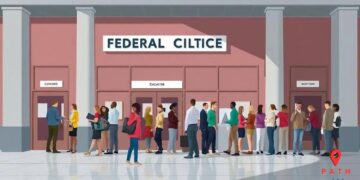FAFSA Update 2025: What It Means for Your College Funding

Anúncios
The updated FAFSA application will impact 2025 college funding by streamlining the application process, expanding eligibility for need-based aid, and adjusting the calculations used to determine a student’s financial need, potentially leading to more students receiving assistance.
Navigating the landscape of college funding can be daunting, especially with the ever-evolving rules and regulations. The **updated FAFSA application** is set to bring significant changes for the 2025 academic year, potentially impacting how students and families plan for and finance higher education.
Anúncios
Understanding the FAFSA Simplification Act
The FAFSA Simplification Act represents a sweeping overhaul of the Free Application for Federal Student Aid (FAFSA). This act aims to streamline the application process, making it easier for families to apply for financial aid and potentially increasing the number of students eligible for assistance.
Anúncios
Key Goals of the Act
The FAFSA Simplification Act has several key objectives designed to improve the accessibility and efficiency of the financial aid system.
- Reducing Complexity: By simplifying the application form and the underlying calculations, the act seeks to reduce the burden on families and students.
- Expanding Eligibility: The changes are intended to broaden the pool of students who qualify for federal financial aid, particularly Pell Grants.
- Improving Accuracy: By refining the data collection process, the act aims to ensure that financial aid is distributed more equitably and accurately.
Ultimately, the FAFSA Simplification Act is poised to reshape how students and families approach college funding.
Major Changes in the Updated FAFSA Application
Several significant changes have been introduced in the updated FAFSA application, each with the potential to impact a student’s eligibility for financial aid. Understanding these changes is crucial for families preparing for the 2025 academic year.
Changes to the Student Aid Index (SAI)
One of the most notable changes is the replacement of the Expected Family Contribution (EFC) with the Student Aid Index (SAI). The SAI provides a clearer picture of a student’s financial need.
Income Protection Allowance Adjustments
The updated FAFSA also includes adjustments to the income protection allowance, which impacts how much of a family’s income is shielded from consideration when determining financial aid eligibility.
Keep abreast of these changes to determine how they will affect your eligibility for financial assistance.

How the Changes Will Affect Pell Grant Eligibility
Pell Grants are a cornerstone of federal financial aid, providing need-based grants to low-income undergraduate students. The changes to the FAFSA application are expected to have a significant impact on Pell Grant eligibility.
Expanded Access to Pell Grants
The FAFSA Simplification Act aims to expand access to Pell Grants by revising the eligibility criteria and increasing the maximum grant amount.
Impact on Low-Income Families
Low-income families are likely to see the most substantial benefits from the changes to Pell Grant eligibility. The revised criteria take into account a broader range of financial factors, potentially leading to more students from disadvantaged backgrounds receiving Pell Grants.
Consider these points when considering the Pell Grant applicability to you.
Strategies for Maximizing Your Financial Aid
Despite the changes to the FAFSA application, there are still strategies that students and families can employ to maximize their eligibility for financial aid. Understanding these strategies can help make college more affordable.
- Complete the FAFSA Early: Submitting the FAFSA as soon as it becomes available (usually October 1st) increases your chances of receiving aid, as some funds are awarded on a first-come, first-served basis.
- Accurately Report Financial Information: Ensure that all financial information provided on the FAFSA is accurate and up-to-date. Errors or omissions can delay the processing of your application or reduce your eligibility for aid.
- Explore Additional Aid Options: In addition to federal financial aid, explore other sources of funding, such as state grants, scholarships, and private loans.
Remember to start early and search for the most beneficial options for financial aid.
Understanding Dependency Status and Its Impact
Dependency status plays a crucial role in determining eligibility for financial aid. Whether a student is considered a dependent or independent affects whose income and assets are considered on the FAFSA.

Criteria for Independent Status
Students who meet certain criteria are considered independent for FAFSA purposes. These criteria include age, marital status, having dependents, military service, and being an orphan or ward of the court.
Impact on Financial Aid Calculations
If a student is considered dependent, their parents’ income and assets are included in the financial aid calculations. This can significantly impact the amount of aid a student is eligible to receive.
Review the implications of financial independence and how it affects college funding.
Navigating the FAFSA Application Process
The FAFSA application process can seem complex, but breaking it down into manageable steps can make it more approachable. Here are some tips for navigating the application process effectively.
Gathering Required Documents
Before starting the FAFSA application, gather all the necessary documents, including social security numbers, tax returns, bank statements, and investment records.
Common Mistakes to Avoid
Avoid common mistakes such as entering incorrect information, skipping required fields, and failing to meet deadlines. Review the application carefully before submitting it.
In summary, completing the FAFSA application requires thoroughness and attention to detail.
| Key Point | Brief Description |
|---|---|
| 📝 FAFSA Simplification | Aims to streamline and simplify the FAFSA process. |
| 💰 Student Aid Index (SAI) | Replaces EFC, providing a clearer picture of financial need. |
| 🎓 Pell Grant Changes | Expected to expand access to more low-income students. |
| 📅 Early Submission | Submitting FAFSA early can increase chances of receiving aid. |
Frequently Asked Questions (FAQ)
▼
The FAFSA Simplification Act is legislation aimed at streamlining the Free Application for Federal Student Aid (FAFSA) process and expanding eligibility for financial aid.
▼
SAI replaces the EFC and provides a clearer picture of a student’s financial need, using a new formula that may increase aid eligibility for some students.
▼
Low-income students and families are most likely to benefit from these changes, as the eligibility criteria have been revised to consider a broader range of financial factors.
▼
You will typically need your social security number, tax returns, bank statements, and investment records. Having these documents ready will expedite the application process.
▼
Common mistakes include entering incorrect information, skipping required fields, and missing deadlines. Review your application carefully and submit it early.
Conclusion
The updated FAFSA application for 2025 brings both opportunities and challenges for students and families seeking financial aid. By understanding the changes, employing effective strategies, and navigating the application process carefully, you can maximize your eligibility for aid and make college more affordable.





